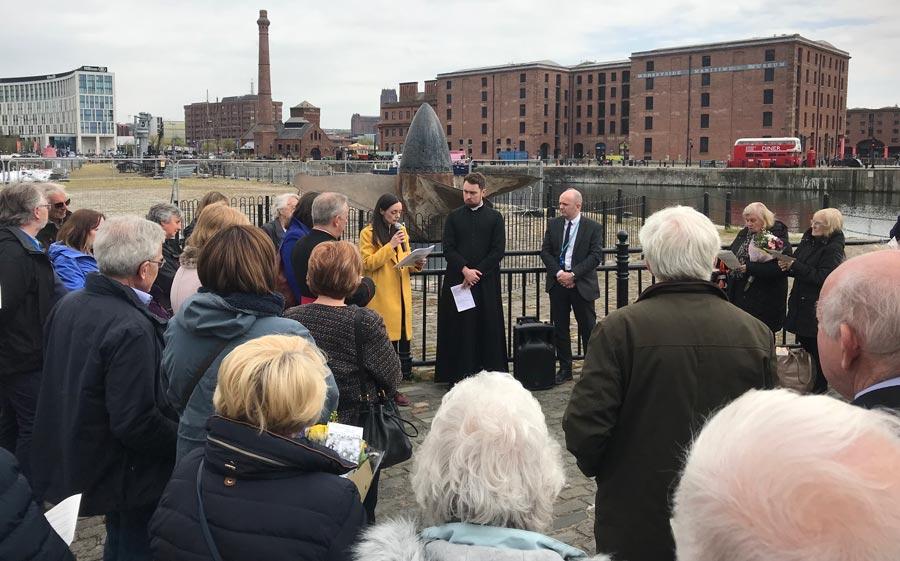RMS Lusitania – we remember

7 May 2020 marked the 105th anniversary of the sinking of RMS Lusitania, torpedoed by German submarine U20, off the coast of southern Ireland. The story of Lusitania is one of our most significant here at the Maritime Museum. Our gallery Lusitania: life, loss, legacy has people at the heart of the story. The sinking of the ship touched lives across the world but was felt particularly strongly in Merseyside due to the ship’s close connections with Liverpool, including many of her crew coming from the local area. For almost 8 years 'Lusi’ was a familiar sight at the landing stage during her regular crossings between Liverpool and New York.
Each year on 7 May we gather alongside the ship’s propeller (one of three salvaged from the wreck) and take part in a commemoration to reflect on those who were lost, how their loss affected their loved ones, and their legacy which still felt by family members who attend. Obviously, that wasn’t an option during lockdown, but our friends at Liverpool Parish Church have kindly produced a film that encompasses elements of the service and brings us together in spirit, if not in body. You can watch it here.
As part of our annual service, we invite a relative to tell their family’s story and in 2020 Catherine Tyrrell shared the experiences of her grandmother, and reflects on Lusitania’s legacy within her family:
“My grandmother was 12 when she boarded the Lusitania in May 1915. Her name was Avis Dolphin. She was being sent to England from Canada to live with her grandparents and to go to school there. Her widowed mother ran a nursing home, and she sent Avis off in the care of two young girls, Hilda Ellis and Sarah Smith, one of whom worked as a nurse in the home.

This photo shows Avis in July 1915, she is wearing the clothes she was wearing at the sinking. Courtesy of Catherine Tyrrell
Avis was very seasick and was befriended on board by a rather flamboyant gentleman, Professor Ian B Stoughton Holbourn, who felt sorry for her. They were both travelling second class, and the Professor entertained Avis with stories of his home and family.
When the torpedo struck on 7 May they were all at lunch. The Professor sought out Avis, Hilda and Sarah and put a lifebelt on Avis. He tried to persuade one of the girls to take his own lifebelt, but she refused saying that he had to live for his children. He then made sure they were all put into a lifeboat.
Sadly, as the lifeboat was lowered, several men jumped in and overturned the boat, throwing all into the sea. My grandmother remembered being dragged down in a vortex as the Lusitania sank, but she eventually surfaced thanks to her lifebelt. Hilda and Sarah were never seen again. Avis was eventually pulled onto a life-raft and, after some time, into a rescue boat. She later recounted the distress of women in the boat who had lost babies, and of watching people gradually freeze to death in the water around. Dreadful things for a twelve-year-old to witness.
Once in Queenstown, Avis was reunited with Professor Holbourn on May 8th. He had jumped overboard and managed to swim to a lifeboat, and was eventually rescued, but suffered the effects of prolonged time in the water. Once he was fit enough to travel, he escorted Avis to England and her grandparents. He took a personal interest in her all his life, and they remained in touch until the Professor died in 1935.

Telegram with the message 'Avis saved - Louie', sent to Avis' mother by her Aunt Louisa, who was waiting to meet her in Liverpool. Courtesy of Catherine Tyrrell
My granny was 93 when she died, so I remember her well, and with great fondness. My own children also have some memories of their great granny! She was a lovely lady, she always seemed calm, and very caring and thoughtful toward others.
I grew up hearing about her Lusitania story from time to time, but I think she protected us to a degree from the true horror of what she went through. At twelve years old, sent away from her mother and siblings to live in a strange country, with the grandparents she didn't know, and then to experience one if the worst maritime disasters in history.
It was only as an adult that I really began to appreciate what she must have experienced, the horrors I know she witnessed in the sea that day, and I now wonder at how she survived that trauma, and moved forward from it, without the counselling and support that would have been offered to victims today. I know that Professor Holbourn suffered nightmares and flashbacks for years. He would have been diagnosed with PTSD today. My aunt, who is alive today, asked her mother once about support after the tragedy, and granny answered that they ''were just expected to get on with it".
Avis met her future husband Tom Foley, at the Holbourn’s house in Edinburgh. Following Toms death in 1979, she moved to Snowdonia where she lived the rest of her life.
I was brought up on Merseyside, close to the Lusitania's home port, but have moved south and I now live near another famous dockyard at Portsmouth. I feel I have a real link to history through my granny, and as I have come to know other descendants linked to the same story, I feel that we are very much a part of a 'Lusitania family'. Since the centenary in Cobh, I have tried to meet up with some of this family on 7 May each year, and between us I hope we can keep the memories alive for future generations."
